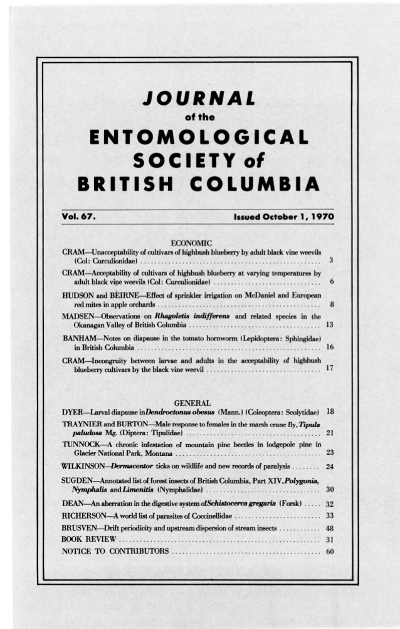Male response to females in the marsh crane fly <i>Tipula paludosa</i> Mg.(Diptera: Tipulidae)
Keywords:
marsh crane fly, <i>Tipula paludosa</i>, Diptera, TipulidaeAbstract
Laboratory and field experiments suggest that male <i>T. paludosa</i> receive a specific mating stimulus only in close proximity of a female. The anterior part of the female rather than the isolated abdomen is the source of the sex pheromone. Attempts to extract the material were unsuccessful.References
Coulson, J.C. 1962. The biology of Tipula subnodicornis Zetterstedt. with comparative observations on Tipula paludosa Meigen. J. Anim. Ecol. 31:1-21.
Kellogg, F.E. and R.H. Wright. 1962. The olfactory guidance of flying insects. IV. Drosophila. Can. Ent. 94:884-888.
Wilkinson, A.T.S. and H.R. MacCarthy. 1967. The marsh crane fly, Tipula paludosa Mg., a new pest in British Columbia (Diptera: Tipulidae). J. Entomol. Soc. Brit. Columbia 64:29-34.
Wright, R.H. 1970. Alternatives to Insecticides. Pesticide Science. 1:24-27.
Wright, R.H. 1964. "Metarchon" - a New Term for Class of Non-toxic Pest Control Agents. Nature, 204:603-4.
Downloads
Published
Issue
Section
License
Authors who publish with the Journal of the Entomological Society of British Columbia agree to the following terms:
-Authors retain copyright and grant the journal right of first publication with the work simultaneously licensed under a Creative Commons Attribution License that allows others to share the work with an acknowledgement of the work's authorship and initial publication in this journal.
-Authors are able to enter into separate, additional contractual arrangements for the non-exclusive distribution of the journal's published version of the work (e.g., post it to an institutional repository or publish it in a book), with an acknowledgement of its initial publication in this journal.
-Authors are permitted and encouraged to post their work online (e.g., in institutional repositories or on their website) prior to and during the submission process, as it can lead to productive exchanges, as well as earlier and greater citation of published work (See The Effect of Open Access).


